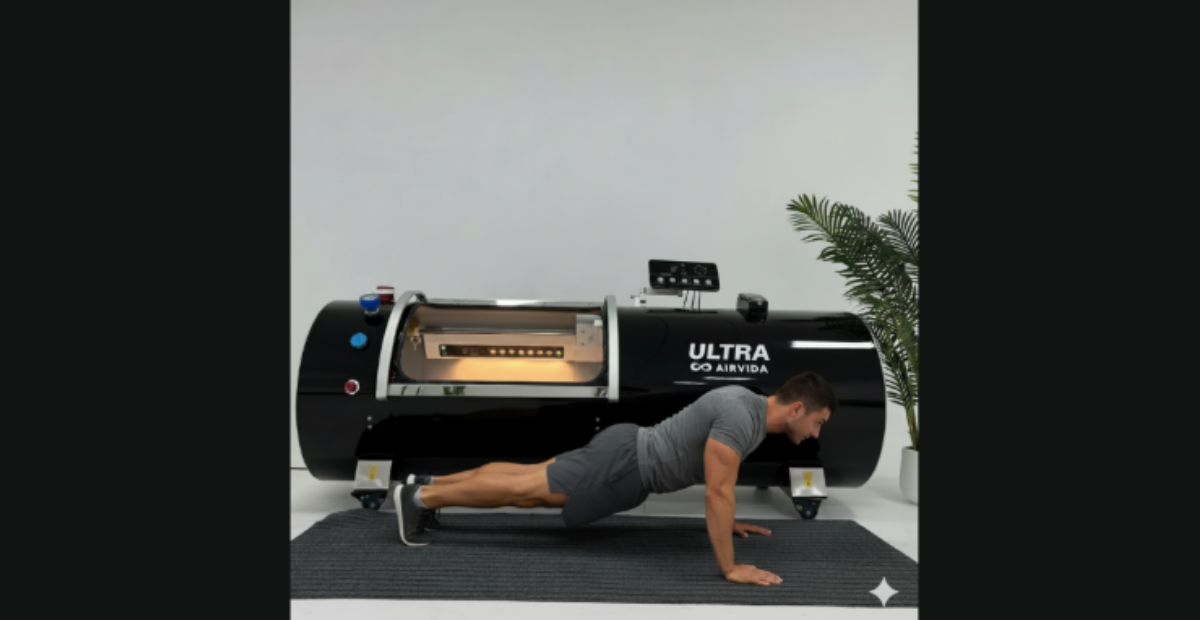Exercise with oxygen therapy combines physical activity with increased oxygen intake to enhance athletic performance, speed up recovery, and support overall health. By providing higher oxygen levels during exercise, it helps cells function more efficiently, accelerates tissue repair, and reduces fatigue, making workouts more effective and promoting long-term wellness benefits.
Whether you’re an athlete or wellness enthusiast, this innovative approach can elevate your body’s performance and recovery. From improving endurance and energy levels to supporting faster healing after workouts or injuries, exercise with oxygen therapy adapts to your goals. Understanding how it works and choosing the right setup ensures safe, effective, and lasting results.
What Is Exercise with Oxygen Therapy?

Exercise with oxygen therapy, often called EWOT, involves breathing concentrated oxygen while performing light to moderate exercise such as cycling, walking, or treadmill workouts. The oxygen is typically supplied through a concentrator connected to a mask or headset.
Unlike typical workouts that depend on ambient air (21% oxygen), EWOT sessions deliver oxygen levels as high as 90–95%. This improves how efficiently your body absorbs and uses oxygen, a key factor in performance and healing.
The Science Behind EWOT
Oxygen is vital for producing adenosine triphosphate (ATP), the molecule that fuels every cell. During exercise, the body’s demand for ATP skyrockets. By breathing higher oxygen concentrations, you’re essentially giving your body extra fuel to meet this demand efficiently.
Here’s a simplified look at what happens inside your body:
|
Process |
Standard Exercise (Room Air) |
Exercise with Oxygen Therapy (EWOT) |
|
Oxygen Concentration |
21% |
Up to 95% |
|
ATP Energy Production |
Normal |
Significantly increased |
|
Lactic Acid Build-up |
Higher |
Reduced |
|
Recovery Time |
Longer |
Faster |
|
Cellular Oxygenation |
Moderate |
Deep and sustained |
This increase in oxygen availability enhances endurance, supports detoxification, and boosts immune response, making EWOT popular among athletes, wellness seekers, and those recovering from fatigue or illness.
Why Oxygen-Enhanced Exercise Matters

Your body’s performance largely depends on how well oxygen reaches your muscles, tissues, and brain. During intense activity, oxygen supply often struggles to keep up with demand, leading to fatigue and slower recovery.
EWOT directly addresses that by giving your cells more oxygen when they need it most.
Physical and Wellness Benefits
-
Enhanced Athletic Endurance
Higher oxygen levels improve how efficiently muscles use energy. Many athletes report being able to train longer and recover faster. This means better stamina for runners, cyclists, and anyone who trains regularly.
-
Faster Post-Workout Recovery
By reducing lactic acid accumulation, EWOT shortens recovery time after demanding sessions. Oxygen helps repair muscle micro-tears more efficiently, reducing soreness and inflammation. -
Immune System Support
Oxygenated blood helps white blood cells function better. Consistent oxygen therapy may improve your body’s natural defense mechanisms, leading to better resistance against fatigue and illness.
-
Cognitive Clarity and Energy
Higher oxygen intake benefits the brain, enhancing focus and alertness. Many users report feeling more energized, with better mental clarity, even outside of workouts.
-
Support for Wellness and Healing
For individuals in rehabilitation or managing chronic fatigue, oxygen-assisted workouts support circulation, detoxification, and tissue regeneration.
Want to see the best options available? Explore our HBOT Holiday Sale Collection for exclusive offers on high-quality oxygen therapy systems.
How to Get Started with Exercise with Oxygen Therapy
EWOT can be done safely at home or in professional wellness centers. The setup usually includes an oxygen concentrator, a reservoir bag, a mask, and your choice of exercise equipment, like a treadmill or stationary bike.
1. Choosing Your Equipment
Selecting the right equipment is essential for effective Exercise with Oxygen Therapy (EWOT). A standard oxygen concentrator typically delivers between 5 and 10 liters per minute, filling a 900–1000-liter reservoir bag that provides steady oxygen during workouts. For consistent, high-purity oxygen delivery, explore the Hyperbaric O₂ Chambers Collection crafted for performance, recovery, and long-term wellness.
2. Safe Oxygen Concentration Levels
Safety should always come first when performing EWOT. Begin with a moderate oxygen concentration of around 90% during 10–15 minutes of steady exercise. Ensure all connections are tight using medical-grade tubing, and your mask fits snugly. Avoid smoking, sparks, or open flames nearby, and maintain proper airflow for maximum safety.
3. Best Exercises for EWOT
You don’t need high-intensity workouts to experience EWOT’s benefits. Moderate exercises such as brisk walking, cycling, or treadmill sessions help optimize oxygen circulation throughout the body. The goal is steady, rhythmic breathing that complements oxygen intake, improving endurance, recovery, and overall energy without overexertion or unnecessary strain on the cardiovascular system.
|
Exercise Type |
Duration |
Benefits |
|
Stationary Cycling |
15–20 min |
Enhances stamina and cardiovascular health |
|
Treadmill Walking or Jogging |
10–15 min |
Improves circulation and oxygen absorption |
|
Rowing Machine |
10 min |
Engages multiple muscle groups and boosts endurance |
|
Gentle Yoga or Stretching |
10 min |
Supports oxygen flow and recovery |
Combining EWOT with Other Therapies
Many wellness centers pair exercise with oxygen therapy, with methods like red light therapy or hyperbaric oxygen chambers. This combination further enhances tissue oxygenation and recovery.
To learn more about finding reputable facilities, check out our guide:
How to Find a Hyperbaric Chamber Near Me
Or, if you’re exploring seasonal offers on oxygen therapy products, see:
Best HBOT Holiday Sale for Oxygen Systems
These additional resources explain how oxygen-based technologies complement your health and performance goals.
Practical Tips for Success
-
Stay Consistent: Like any exercise program, results come with regular use. 3–4 EWOT sessions per week deliver optimal benefits.
-
Hydrate Well: Oxygen circulation improves blood flow; proper hydration enhances its effects.
-
Track Progress: Monitor your heart rate and oxygen saturation using a smartwatch or pulse oximeter.
-
Consult a Professional: Especially if you have cardiovascular or respiratory conditions, get medical guidance before starting.
Understanding the Difference: EWOT vs. Hyperbaric Oxygen Therapy
While both increase oxygen intake, they do so differently:
|
Feature |
Exercise with Oxygen Therapy (EWOT) |
Hyperbaric Oxygen Therapy (HBOT) |
|
Oxygen Delivery |
Inhaled during exercise |
Inhaled in a pressurized chamber |
|
Pressure Level |
Normal air pressure |
1.3–3 ATA (increased pressure) |
|
Session Duration |
10–20 minutes |
60–90 minutes |
|
Key Benefit |
Boosts oxygen metabolism & endurance |
Enhances deep tissue healing |
|
Best For |
Active recovery, fitness, energy |
Chronic wounds, neurological repair |
EWOT is ideal for daily use and long-term health maintenance, while HBOT is more specialized for medical or therapeutic applications. Both share the same goal: improving oxygen delivery to every cell.
Who Can Benefit from EWOT
Anyone aiming to improve oxygen efficiency and overall wellness can benefit from this therapy. It’s ideal for athletes seeking faster recovery, individuals managing fatigue, professionals looking to boost focus, and those exploring natural wellness methods. Essentially, anyone wanting to enhance energy, circulation, and performance may find oxygen-based exercise a valuable addition.
-
Athletes recovering from intense training
-
People managing chronic fatigue or poor circulation
-
Those recovering from respiratory issues
-
Seniors aiming to improve mobility and energy
The versatility of exercise with oxygen therapy makes it accessible to almost everyone, regardless of age, fitness level, or experience. Whether you’re an athlete aiming to boost endurance, a professional managing daily fatigue, or a senior supporting healthy aging, this adaptable method provides measurable wellness benefits through improved oxygen utilization and recovery support.
Final Take on Exercise with Oxygen Therapy
Exercise with oxygen therapy is a simple yet scientifically supported method designed to boost endurance, recovery, and overall wellness. By combining physical activity with concentrated oxygen intake, your body can produce energy more efficiently, repair tissues faster, and reduce fatigue. This technique promotes better circulation, improved metabolism, and enhanced oxygen utilization at the cellular level.
Understanding its science and proper application allows you to unlock the full potential of this therapy safely and effectively. When performed correctly, it can support both athletic performance and everyday vitality by optimizing oxygen delivery, reducing inflammation, and aiding recovery. The key lies in consistency, balanced effort, and correct oxygen concentration control.
For deeper learning, explore our educational post on hyperbaric chamber benefits near you and discover how oxygen-based wellness can change your health journey.
Frequently Asked Questions
What should you not do with an oxygen concentrator?
You should never smoke or use open flames near an oxygen concentrator. Oxygen supports combustion, so keep it away from heat sources. Avoid blocking airflow vents, and ensure the concentrator sits on a stable, open surface. Always unplug the device when cleaning or refilling accessories to ensure safe operation.
What is the best exercise to get oxygen?
The best exercises to get oxygen are those that promote consistent breathing and full-body movement, like walking, cycling, or swimming. These aerobic activities improve cardiovascular function and increase lung capacity, helping your cells absorb more oxygen efficiently. Combining them with EWOT enhances results even further.
What happens to oxygen when you exercise?
When you exercise, oxygen is used by muscles to create ATP, the energy molecule that fuels movement. As intensity rises, your body pulls more oxygen from the blood, improving efficiency. Over time, this adaptation strengthens your heart and lungs, helping you perform longer with less fatigue.
Why do people run on a treadmill with an oxygen mask?
People run with an oxygen mask to increase oxygen delivery during physical activity. This allows muscles to produce more energy while reducing lactic acid buildup. The result is better endurance, faster recovery, and improved overall performance, a key reason athletes and wellness enthusiasts embrace EWOT.




